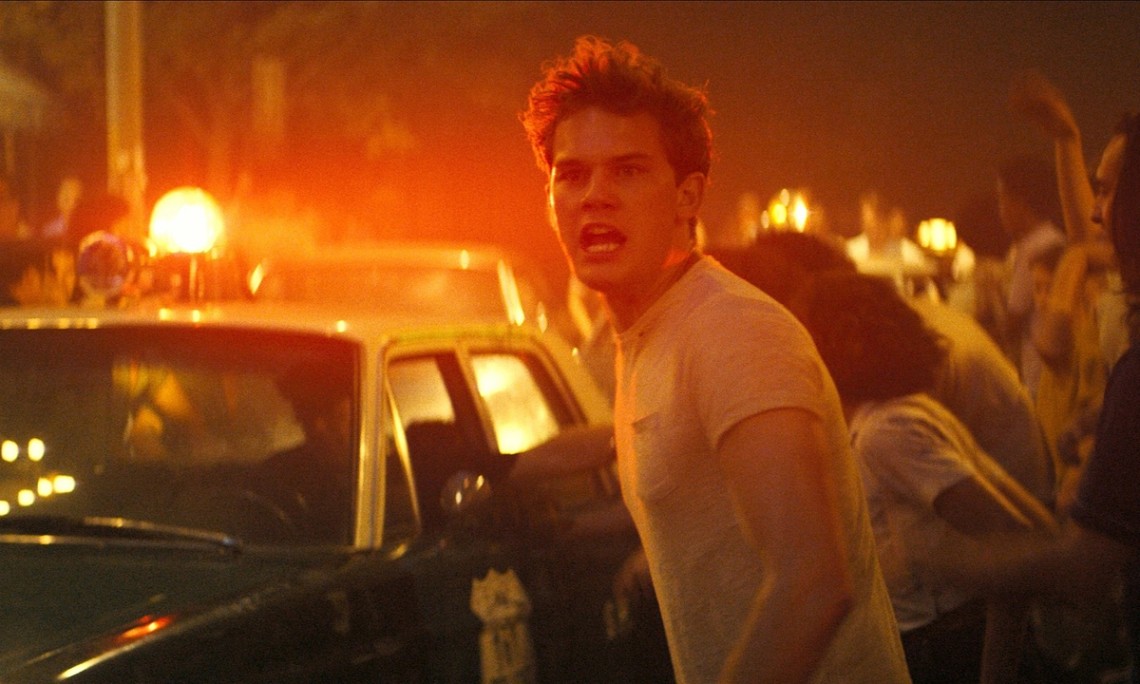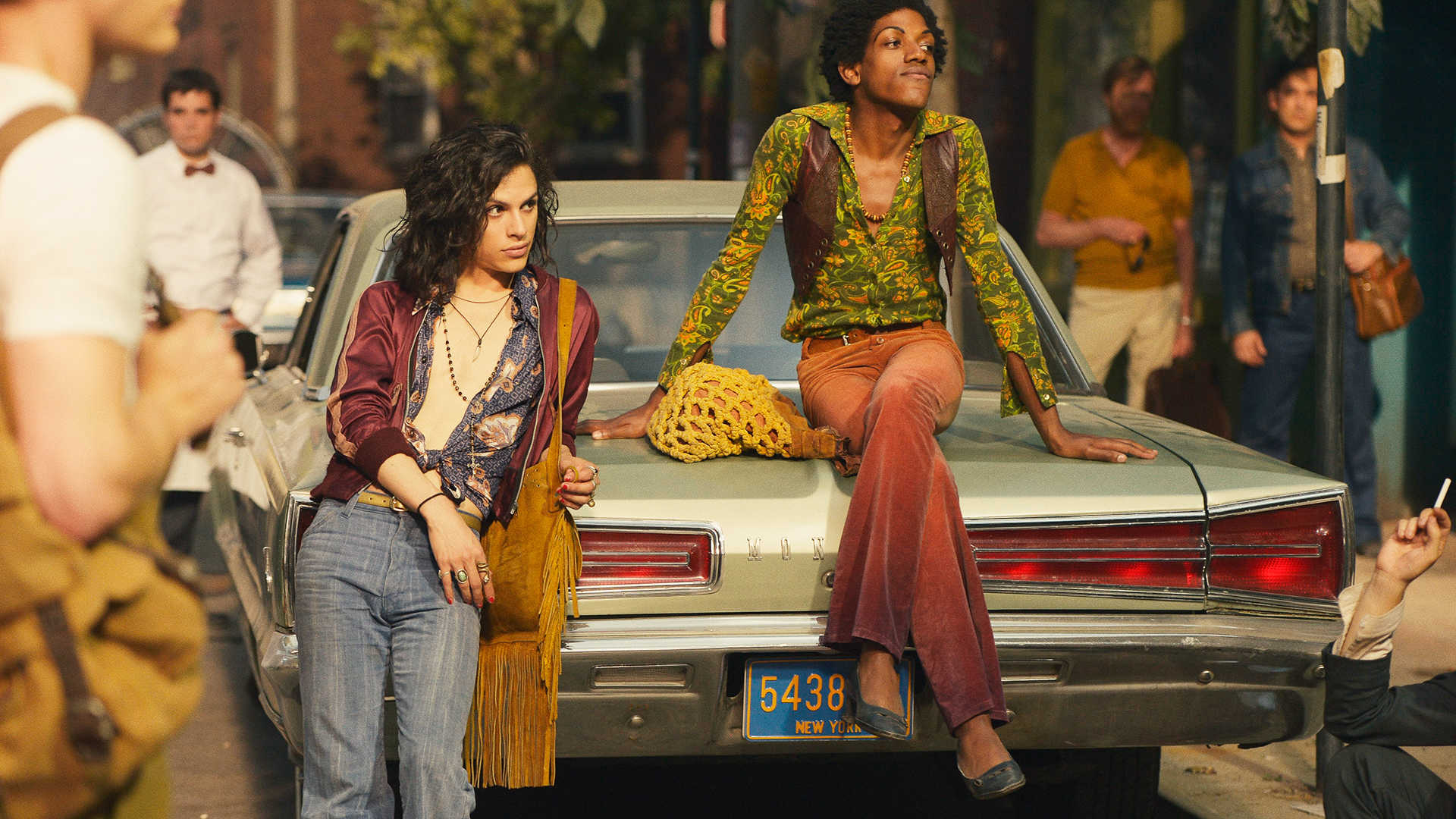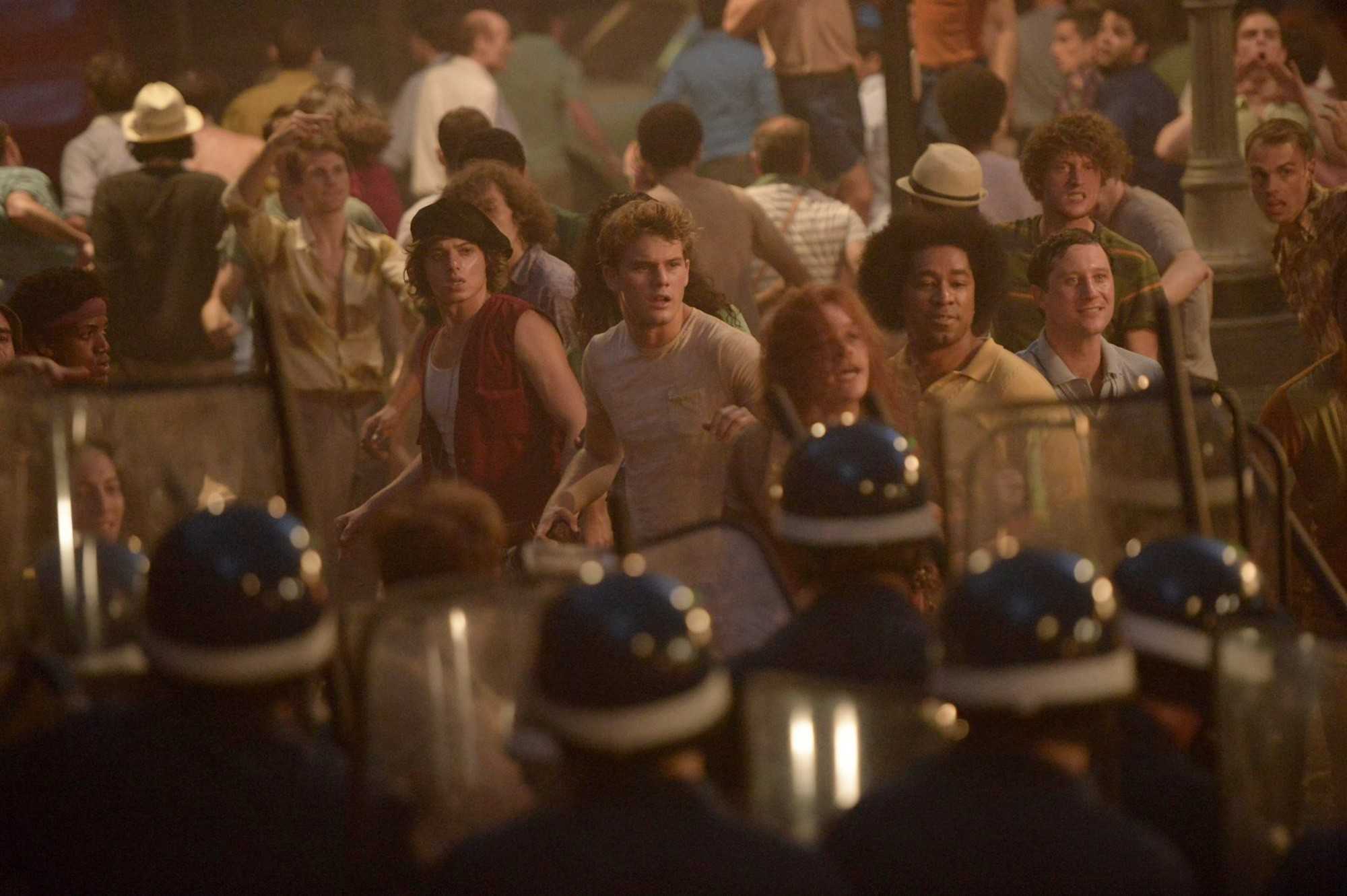Writing about Roland Emmerich’s Stonewall has been in the back of my mind since the project was announced in 2013, before the trailer, before the promo images. Its presence in my mind as something to consider in any sense was twofold: first, as a newly out queer person; and second, as a cinephile (though dichotomizing those aspects of my identity is a non-starter: they’re equally important to me). And I went into Emmerich’s film with as open a mind as possible, despite having read dozens of thinkpieces mostly ravaging the film (though a couple were relatively thoughtful in their defensiveness or ambivalence, and some just completely ridiculous in their defense). But something about Stonewall, both as a movie and as a piece of pop culture, fascinates me, for reasons both right and wrong.
To probably no one’s surprise, let me be clear: Stonewall is not a good movie. On a purely narrative and aesthetic level, it mostly stinks to high heaven. And much of this exists in a strange paradox: Despite the film explicitly taking place in New York City’s West Village, there’s a blatant artificiality to the entire environment. It’s weird to see streets, fences, sign posts, and buildings—ones that I should recognize—stripped of their bohemian beauty.
But the fakery of the world that’s created is distracting, as if trying to compensate for other shortcomings, like cinematography and dialogue. It’s color-graded in tungsten for a reason unbeknownst to me; if it’s an attempt to oscillate between the sunshine-y loveliness of Christopher Street’s finest and the piss-stained reality of their situations, it comes off as not only ugly-looking, but also offensive in the way it fetishizes poor people in an almost pornographic manner.
These buildings and landmarks looked painted on lazily, shack-like, taking on a downtrodden quality with an ironic cleanliness to it. This visual approach is strange considering the film’s supposed desire to be rooted in realism. The attempt at verisimilitude starts with the first frame, Courier New-typed with the invisible hand of history, spelling out the historical realities that queer people faced. Shots from the riots are graded in black and white, some moments pausing like a still newspaper image. The audience is ostensibly thrown into one of the most powerful moments of civil unrest in American history.
And yet, what is the point of verisimilitude if one is to insert an entirely fictional character into the story, audience surrogate or otherwise? On the one hand, arguing over the minutiae in Lincoln when the stakes for cultural and social repercussions are pretty low is irksome, but the argument over Stonewall’s accuracy speaks to something larger. There is a certain amount of disagreement as to the catalyst for the events at the Stonewall Inn in 1969, but it is generally agreed upon, by scholars such as Leslie Feinberg and Stephan Copeland, that trans and queer people of color, like Marsha P. Johnson and Sylvia Rivera, were among the most active during the events, along with the homeless queer youth.
Upon the premiere of Stonewall’s trailer, accusations of whitewashing were thrown at Emmerich and the film, leading Emmerich to protest what he felt were unfair quick reactions. The film, alas, proves those initial accusations to be basically correct. Both Meredith Talusan and Joe Reid describe queer people of color in the film as “window dressing;” really, though, they are more like cartoon characters. Marsha P. Johnson is there, but her role is relegated to little more than delivering witty non-sequiturs. The rest of them, as far as narrative convention goes, barely show main character Danny (Jeremy Irvine) the ropes in a compelling manner, save for the genderqueer Ray/Ramona. And even when the resistance starts, they’re not much more than the AI in a single-player story-mode mission in a video game, while the camera focuses on someone else.
Much has been made about Irvine’s character, Danny, and his role in the film on both a micro and macro level. For one thing, he’s completely invented—not even a composite character like Ray (a mix of Ray Castro and Sylvia Rivera). The commitment to historical authenticity stops when you talk about Danny, not because of his fictitiousness, but because of what the character represents as a whole.
Emmerich has mentioned in interviews that Danny is meant to be the audience surrogate, the one the audience is supposed to follow and sympathize with when diving into the unfamiliar landscape of Christopher Street. What Emmerich and some defenders of the film don’t understand is that Danny is representative of an ideal: masculine-presenting and -performing, white, and conventionally attractive. Ed “Skull” Murphy (Ron Perlman) refers to him as “all-American,” while Ray describes him as a “Ken doll.” There is a duality to what he represents: a) the ideal (straight, white, middlebrow) audience member to whom Emmerich is explicitly pandering; and, b) the ideal queer person. The homonormative ideal is basically Neil Patrick Harris: clean-cut, nice, unassuming, cisgender, upper- to upper-middle class, educated, masculine-performing, often urban, and white. This is a terribly narrow idea of queerness and queer people. Trans and queer people have already had their culture appropriated by white gay men (such as Paris is Burning), and Stonewall just feels like another example of exclusion of the diversity of voices and peoples involved.
It isn’t only Danny’s whiteness that rankles, but also his class aspirations. Surprisingly, the world of the West Village isn’t romanticized, at least not necessarily in the overly nostalgic way one might expect. Instead, the hyper-stylization accentuates the grit and grossness of the area, suggesting the low opinion the filmmakers have toward the sex work that the young queer people engage in.
But the people Danny most aspires to are those that live some semblance of a conventional lifestyle: the unofficial landlord and his partner with their nice apartment; Mattachine mouthpiece Trevor (Jonathan Rhys Meyers) and his carefully furnished apartment; his former lover and star quarterback Joe (Karl Glusman) and his family’s place. These sequences are shot and framed like a Hallmark commercial, with light pouring into the frame. Yet, in comparison, the dramatic techniques used to illustrate the lives of the queer youth are always keyed into a kind of melodrama that often feels overwrought, where the film’s ideological perspective on class leaks through. At the end of the film, Danny returns to visit his friends, and while they’re still on the street, he’s off studying at Columbia.
At only one point does anyone call Danny out on his privilege: when Ray points out the differences between decisions and necessity. Naturally, though, little more is made of this. The filmmakers never seem to grasp the irony of Danny spending so much of the film wanting to escape from the people who initially welcomed him.
The use of the white savior as a trope in films dealing with civil rights issues isn’t new. From Mississippi Burning to The Help to Django Unchained, there’s this trend of directors belonging to a more dominant group relying on that trope, often with the same motivations as Emmerich had articulated in the aforementioned interviews. And yet, each time one of these directors tries to serve a larger and arguably more homogenous audience, it’s at the sacrifice of allowing the stories of the marginalized to be told with the kind of honesty and authenticity that they not only deserve, but that can be done with a perspective those who experience it are best able to give.
Selma is an interesting example: a period piece that dramatizes another moment of civil unrest and examines the people involved, including its central figure, Martin Luther King, Jr. Written and directed by black female director Ava DuVernay, Selma is striking precisely because of its unwillingness to pander. Its emotions are profound and organically conceived. There’s not a white savior in sight. So, as Selma proves, the question of how one can do a movie like this without an audience stand-in is a nonstarter, because you don’t need an audience stand-in. Kevin O’Keefe writes, “Stonewall Forrest Dumps an inoffensive but uninteresting young guy into history alongside fascinating real people, then only tells his story.” If anything, that sells Forrest Gump short. If one reads Zemeckis’s film as ironic satire, it’s critiquing the paradigm of the greatest moments in history being written by white men. In addition, Forrest Gump texturizes its world with believable, detailed sociopolitical context, something Stonewall does not do.
There’s not much in the name of politics in Stonewall, and when there is, it’s eaten up by Danny’s story arc. What’s going on in the country, particularly within New York, is perfunctorily spelled out, without cognizance of the greater ideological values at stake. Kyle Buchanan pointed out the irony of the film demonizing Mattachine, a gay-liberation group that favored an assimilationist style of rhetoric, while opting for a cis, white, masculine male to appeal to mainstream audiences. The irony runs deeper than that, though, because the ostensible radical politics and the conventional middle-class aspirations don’t mix well in this film. That’s not to say that they don’t mix well in general, but the lack of commitment to political ideology further bungles the mess. But the film is too focused on Danny to care, anyway.
The fundamental problem with Stonewall, then, is: It’s not really about Stonewall at all, or about the politics of queer rights. Danny is the focal point of everything. Even during the riots, the rest of the cast is barely discernible, but you can always make out Danny in the crowd. The instigating brick thrown in the film by black character Cong (Vladimir Alexis) comes only after he sees Trevor, and that shot/reverse shot implies that it was thrown out of revenge for Trevor cheating on him, rather than as a definitive statement about identity, politics, etc.
And because it is Danny’s story, the emotional swell that one is arguably supposed to feel in this banding together of people for a common cause doesn’t exist. The civil unrest comes at the final 20 minutes of the 2-hour film, but there’s no uplifting sense of a communal empowering action because the film hasn’t been communal by its very nature. This isn’t an ensemble piece. Characters like Ray and Marsha, to a lesser degree, are side characters, barely existing to support Danny. And if there’s any effort put in to examine the political ramifications on Danny personally, that barely exists. It’s all about him, but in the shallowest way possible.
In The Celluloid Closet, Harvey Fierstein intimated that he is in favor of the Baby Steps method to visibility. That documentary, based on the book by Vito Russo, was released 20 years ago. In the years since that doc was released, there’s been a drastic change in the cultural climate as far as queer visibility goes. Why? Because we have demanded it. We have grown tired of the Baby Steps method. So it feels especially regressive that in 2015, we still have to play nice as a way to educate audiences. Yes, I think it’s admirable that Emmerich wanted to bring the events at the Stonewall Inn into public consciousness. But that alone does not let him off the hook for his creative and thereby political decisions. The existence of genuinely progressive films like Tangerine and TV series like Looking puts a cowardly film like Stonewall to shame.
But…I am speaking from a lefty, east-coast, urban-adjacent, social-media-addicted, middle-class, feverishly committed-to-the-cause point of view.
I realized, after reading the innumerable thinkpieces on the film and after a pleasant rewatch of To Wong Foo, Thanks for Everything! Julie Newmar that I never had a moment of self-actualization as a queer person through media. I was fortunate enough to grow up in a pretty liberal family that showed me that aforementioned film at a really young age, and made it clear to me to be accepting and that, hypothetically, were I not straight, everything would be fine. So I never really saw myself in any movies because I didn’t need to. (That’s not to say I didn’t go through 19 years and several thousand dollars’ worth of denial.) And after I came out, my queer identity merged with my cinephilic one, and to me, they’re inextricable now.
But I know people aren’t as lucky. Maybe seeing Stonewall will be a good thing for someone, so long as it catalyzes them to explore queer history on their own. Maybe seeing a character like Ray will allow someone to be more comfortable in their own gender expression. Maybe it’ll propel someone to explore queer cinematic history.
Slate’s J. Bryan Lowder wrote the piece on Stonewall that I probably most agree with, at least as far as its reticence to add to a din of thrashing. He writes:
The point is that we all, whether we intend to or not, decide for ourselves what a thing like Stonewall means—that’s just the nature of encountering history. …Stonewall was a moment when we all put aside our differences and united to finally fight back—or at least that’s what most of us want it to have been. Stonewall, on the other hand, comes at a moment when the always jury-rigged alliance between the various queer contingents feels more uncertain every day; when our debates over terminology, community norms, political goals, and paths toward social justice feel increasingly fractious.
As bad as Stonewall is as a film—with its poorly written screenplay, often-atrocious cinematography, and a dire lead performance from Irvine—as a niche phenomenon, Stonewall is indeed a bit of a litmus test. It’s maybe ironic that the results of that test should reveal a group of people with such disparate ideas of what it means to embrace that identity, abolishing the idea of a monolithic “gay community,” but political and personal self-actualization isn’t a bad thing. It might just be another brick in the wall.





















3 thoughts on “Another Brick: On Identity, Politics, and “Stonewall””
How ironic that Danny was invented to appeal to straight audiences, as if straights are all bigots who only wish to see themselves. Someone should tell Laverne Cox and Rupaul, both who have attracted far more straight folks than Stonewall. Perhaps someone should tell Shonda Rhimes that Viola Davis needs to be white to appeal to the mainstream. Kerri Washington, since she’s not white, can’t appeal to the mainstream. The age old adage of old age white men in Hollywood has been proven a big, fat lie. Gig’s up. We’re on to you. You just wanted to cast someone you thought was attractive. The fact the Viola Davis and Laverne Cox and Ellen Degeneres and Serena and Obama are wildly popular and successful speak to the fact that the “mainstream” isn’t as bigoted as Hollywood has always portrayed them. Turns out Hollywood has been selling us on that for ages. Some German dude thinks he can re-write our history and tell it to us? Roland, you can get together with Bryan Singer and Randal Kleiser and perv on all the young guys you want at your home. From his own mouth Roland says he, (this important, busy, big-time director) flew to London just to meet “Danny.” That’s right. This big director flew 10+ hours to meet a lone nobody actor and he didn’t even bother to audition any others beforehand. He then invited the young man to his London house. You’ll find this on YouTube: “Roland Emmerich Talks ‘Stonewall,’ the Theme of Unrequited Love and Self-Financing.” From the decision to fabricate a white character, to the manner in which this guy was hired.. So wrong, perverted, disrespectful.
Pingback: 15 from 2015 « I Like Things That Look Like Mistakes
Pingback: Ludicrously Tragic: On New Camp | Movie Mezzanine